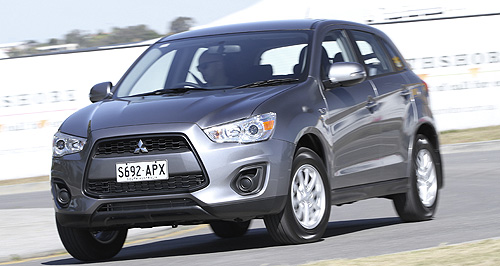New models - Mitsubishi - ASXMitsubishi ASX goes under the scalpelThat’s better: Mitsubishi’s baby SUV, the ASX, has not only received a new face but also some needed tweaks under the skin. Facelifted Mitsubishi ASX gets tweak to CVT auto to make it more appealing24 Aug 2012 MITSUBISHI has given its ASX a mid-life nip and tuck while also addressing some issues that have held back sales of its otherwise successful small SUV since it was launched in 2010. The most obvious changes are to the front and rear facias, which have been rounded off and dressed with some chrome trim to give them a more upmarket appearance while edging the design towards the Japanese company’s new styling language that will be seen in all its glory in the ASX’s all-new, up-coming big brother, the Outlander, due at October’s Australian International Motor Show in Sydney. Under the skin, however, the engineers have been at work rectifying some perceived shortcomings of the ASX, which many critics felt was underdone when it landed Down Under. The continuously variable transmission (CVT) – optional with the 110kW/197Nm 2.0-litre four-cylinder petrol engine – has been given an engineering pull-through to improve its acceleration characteristics and reduce what Mitsubishi product manager James Tol described as “the slipping clutch noise”. The CVT has been reprogrammed to deliver acceleration and engine revs more in line vehicle speed, in accordance with customer expectation. As well, an automatic transmission is in the pipeline for the diesel ASX to broaden the appeal of the frugal 110kW/300Nm 1.8-litre diesel engine that until now has been offered with a sales-stunting six-speed manual gearbox. That transmission will not be available until next year, but Mitsubishi sales staff are gearing up for it anyway. This time around, the diesel will only be offered in the top-self Aspire specification with 4WD, with the previous lower-spec 4WD diesel variant dropped from the range. Other mechanical tweaks include an improvement to the diesel engine fuel efficiency thanks to a new particulate filter – cutting the combined fuel consumption figure from an already good 5.9 litres per 100km, to 5.7L/100km – along with a new rear suspension trailing arm to improve handling, a lighter parking brake and a boost in towing capacity from 1050kg to 1300kg for the petrol models and up to 1400kg for the diesel. The refreshed ASX also gains from a number of changes made to the related Lancer, such as new audio systems, a new steering wheel with improved button functionality, new seat trim with contrast stitching, plus new soft-touch plastics and chrome highlights around the cabin to lift the quality feel. Mitsubishi has also reacted to the increasing customer demand for two-wheel-drive compact SUVs by adding a new 2WD petrol variant, this time in the up-market Aspire specification. This cuts the price of entry to the ASX Aspire from $36,990 to $28,990 – a whopping $8000 difference. Aspire models get a new 6.1-inch touch screen for the iPod control and rear view camera with parking reference lines. Standard equipment includes 17-inch alloy wheels, chrome exhaust, front fog lamps, exterior chrome accents, automatic headlights, and wipers, keyless start, leather upholstery with heated front seats and power driver’s seat adjustment, leather-look door trim and privacy glass. The 2WD Aspire comes standard with both rear parking sensors and a reversing camera. The price of the 4WD Aspire also has been cut, by $2000 to $34,990, for both the 1.8-litre diesel manual and 2.0-litre petrol with CVT, yet gains a panoramic sunroof as standard equipment. While the diesel manual gearbox boasts six speeds, the petrol manual models make do with five. Fuel economy on the 2WD ASX petrol remains unchanged at 7.9L/100km for the CVT and 7.7L/100km for the manual. The base ASX, which remains at $25,990 for the manual and $28,240 for the CVT auto, has not been overlooked, getting improved seat trim, a new audio system, a new steering wheel with audio controls and a Bluetooth hands-free system with voice control. The ASX has been one of Mitsubishi’s success stories over the past two years, capitalising on the runaway success of the compact SUV market. ASX sales this year are up 18 per cent, to 4267 units year-to-date, while small SUV sales are up a whopping 65.7 per cent. Mitsubishi says the market segment is expanding with the arrival of each new model from manufacturers wanting a piece of the small SUV market. However, Mitsubishi says at least some of its ASX buyers are coming from its Lancer Sportback hatch, drawn by the high-riding and more versatile characteristics of the little SUV. ASX sales are now approaching the same levels as Mitsubishi’s ageing Outlander, which is just about to be replaced. However, it is competing in one of the toughest segments in the land, up against the segment-leading Nissan Dualis, Hyundai ix35, Subaru XV and Volkswagen Tiguan, all of which are out-selling the Mitsubishi entrant this year.
 Read moreAll new models Alfa Romeo Alfa Romeo Abarth Abarth Audi Audi Aston Martin Aston Martin BMW BMW Bentley Bentley Chrysler Chrysler Chevrolet Chevrolet Dodge Dodge Citroen Citroen Ferrari Ferrari DS DS Ford Ford Fiat Fiat FPV FPV Foton Foton Haval Haval Great Wall Great Wall Honda Honda Holden Holden Hyundai Hyundai HSV HSV Isuzu Isuzu Infiniti Infiniti Jeep Jeep Jaguar Jaguar Lamborghini Lamborghini Kia Kia Lexus Lexus Land Rover Land Rover Mazda Mazda Maserati Maserati Mercedes-Benz Mercedes-Benz McLaren McLaren Mini Mini Nissan Nissan Mitsubishi Mitsubishi Peugeot Peugeot Opel Opel Proton Proton Porsche Porsche Renault Renault Ram Ram Saab Saab Rolls-Royce Rolls-Royce Smart Smart Skoda Skoda Subaru Subaru SsangYong SsangYong Tesla Tesla Suzuki Suzuki Toyota Toyota Volvo VolvoASX pricing
Motor industry news |
|
||||||||||||||












































Facebook Twitter Instagram